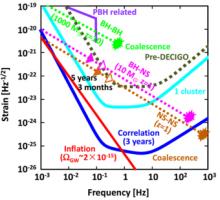
Abstract
The objectives of the DECi-hertz Interferometer Gravitational Wave Observatory (DECIGO) are to open a new window of observation for gravitational wave astronomy and to obtain insight into significant areas of science, such as verifying and characterizing inflation, determining the thermal history of the universe, characterizing dark energy, describing the formation mechanism of supermassive black holes in the center of galaxies, testing alternative theories of gravity, seeking black hole dark matter, understanding the physics of neutron stars and searching for planets around double neutron stars. DECIGO consists of four clusters of spacecraft in heliocentric orbits; each cluster employs three drag-free spacecraft, 1000 km apart from each other, whose relative displacements are measured by three pairs of differential Fabry–Perot Michelson interferometers. Two milestone missions, DECIGO pathfinder and Pre-DECIGO, will be launched to demonstrate required technologies and possibly to detect gravitational waves.